Lubricants Market by Base Oil Type (Mineral Oil Lubricant, Synthetic Lubricants, Bio-based Lubricants), Product Type (Engine Oil, Turbine Oil, Metalworking Fluid, hydraulic Oil), End-use Industry (Transportation and Industrial) - Global Forecast to 2029
In terms of value, the lubricants market is estimated to grow from USD 173.5 billion in 2024 to USD 198.4 billion by 2029, at a CAGR of 2.7%. One of the major reasons for making a positive outlook for the lubricants market is the mounting demand for high performance engines, growing demand from marine application and limitations of electric vehicles. Also, technological advancements in the lubricants are pushing the market. Due to these reasons, the consumption of lubricants has grown significantly
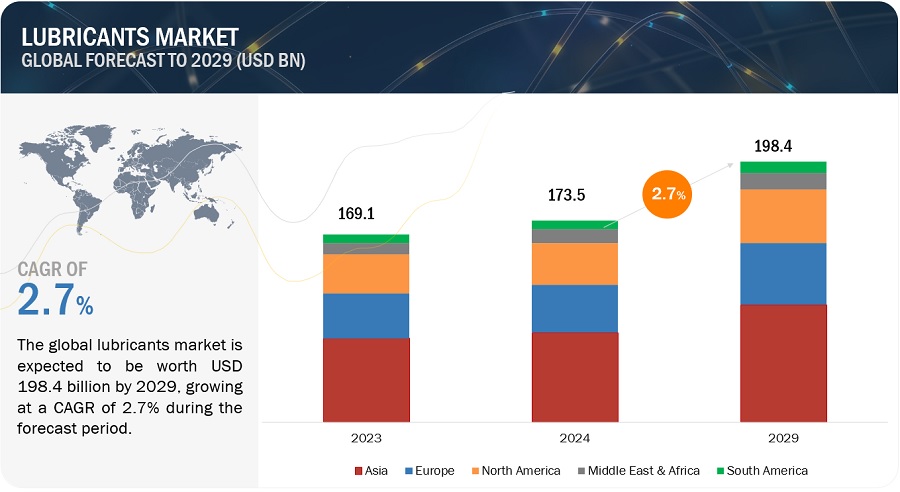
To know about the assumptions considered for the study, Request for Free Sample Report
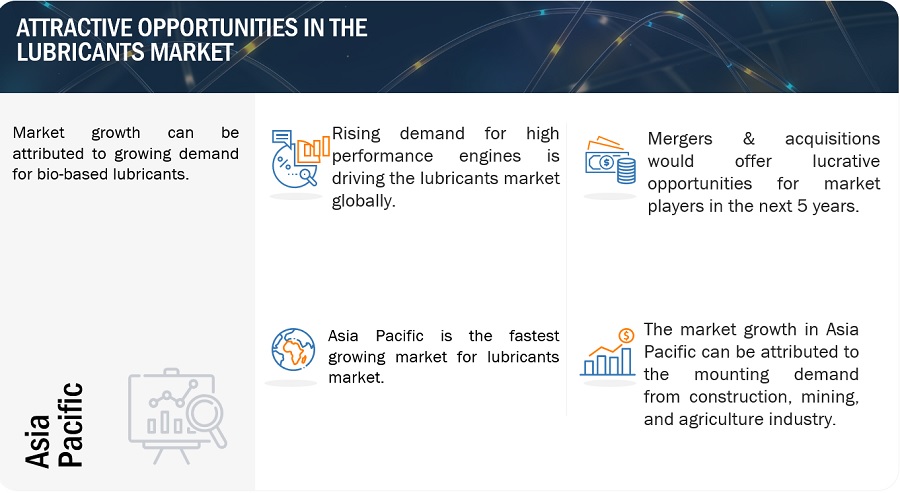
Market Dynamics
Driver: mounting demand from marine applications across worldwide
The global demand for marine applications is boosting the lubricants market due to several factors. Increased seaborne trade is driving shipping volumes and fleet sizes, leading to higher demand for marine lubricants. Stricter environmental regulations are pushing ship operators towards eco-friendly lubricants. Marine lubricants also enhance fuel efficiency and reduce operational costs, meeting stringent regulations from the International Maritime Organization. The growing tourism sector, especially for cruise ships, is favoring demand for marine lubricants. Additionally, ongoing research and technological advancements in lubricant formulations are meeting the evolving needs of the marine industry. Overall, the rising demand for marine applications worldwide is driving the lubricants market forward, emphasizing environmental sustainability, fuel efficiency, cost-effectiveness, tourism sector growth, and technological innovation.
Restraints: growing demand of electric vehicles
The rise of electric vehicles is impacting the lubricants market in several ways. With lower maintenance requirements and extended oil change intervals, there's reduced demand for traditional lubricants. This trend is expected to slow down market volume growth. Additionally, lubricant manufacturers face challenges in adapting to this shift, needing to innovate and develop specialized products for electric vehicles to remain competitive. Overall, the increasing popularity of electric vehicles is reshaping the lubricants market landscape.
Opportunities: Growing demand from construction, mining, and agriculture industries
The booming mining, construction, and agriculture sectors are propelling growth in the lubricants market through increased equipment utilization and a focus on performance and efficiency. These industries heavily rely on machinery such as heavy-duty trucks, excavators, bulldozers, tractors, and harvesters, necessitating high-quality lubricants to ensure smooth operation and longevity. With modern machinery designed for optimal performance under harsh conditions, there is a growing demand for specialty lubricants capable of meeting these stringent requirements. Moreover, the geographic expansion of construction and mining activities, particularly in regions like Asia Pacific and the Middle East, further drives the demand for lubricants as more machinery is put to use. This industrial growth creates opportunities for the lubricants market to thrive by catering to the ongoing need for efficient machinery operation and maintenance.
Challenges: Strict environmental norms
Strict environmental regulations present a significant hurdle for the lubricants market. To comply with these regulations, manufacturers must develop products that are eco-friendly, emit fewer pollutants, and degrade naturally. Additionally, the industry faces pressure to transition towards renewable energy sources and bio-based lubricants to align with sustainability goals. This shift poses challenges but also opens up opportunities for growth. Moreover, the rise of cleaner technologies like hybrid and electric systems threatens the demand for traditional lubricants, potentially impacting market dynamics. Overall, navigating environmental regulations requires innovation and adaptation, presenting both challenges and opportunities for the lubricants industry.
Lubricants Market Ecosystem
Prominent companies in this market include well-established, financially stable manufacturers of lubricants. These companies have been in business for a while and have a broad range of products, cutting-edge technologies, and robust international sales and marketing networks. Prominent companies in this market include Shell plc (UK), Exxon Mobil Corporation (US), BP p.l.c. (UK), Chevron Corporation (US), PetroChina Company Limited (China), TotalEnergies SE (France), ENEOS Holdings, Inc. (Japan), China Petroleum & Chemical Corporation (China), and among others.
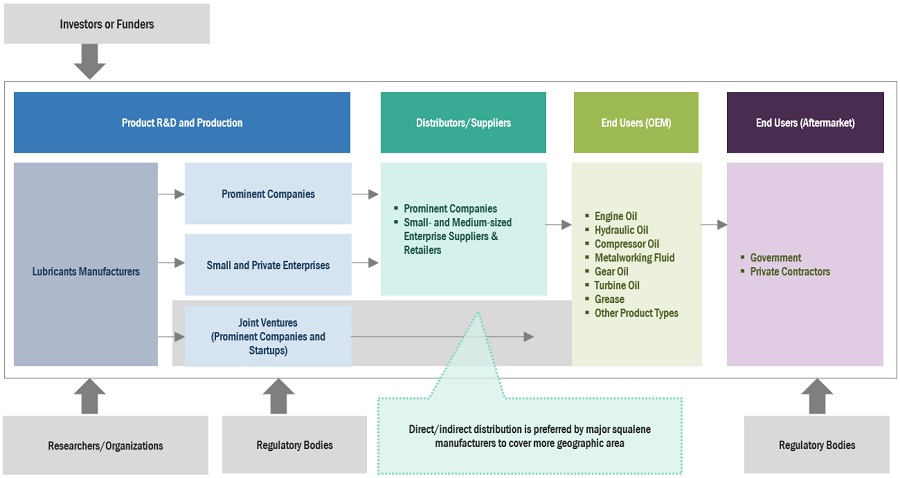
Based on base oil type, synthetic lubricants is projected to register highest CAGR in lubricants market, in terms of value, during forecast period.
Synthetic lubricants is projected to be the fastest growing base oil type, in terms of value of the lubricants market, due to shifting consumer preferences towards eco-friendly and sustainable products, and rising population. With a growing awareness of the health and environmental benefits of synthetic lubricants, consumers are increasingly seeking products free from synthetic chemicals. This demand is further bolstered by stringent government regulations aimed at promoting safety and transparency regarding synthetic lubricants. Consequently, manufacturers are adapting to these changing dynamics by investing in research and development of natural alternatives, driving innovation and expansion in the synthetic lubricatns market.
Based on product type, hydraulic oil was the fourth-largest segment of lubricants market, in terms of value, in 2023.
Hydraulic oil holds the position as the fourth-largest product type in the lubricants market due to its widespread usage across diverse industries. It serves a vital role in hydraulic systems found in industrial and transportation sectors. Hydraulic oil facilitates efficient power transmission, lubricates moving parts, and ensures the smooth operation of hydraulic machinery. The increasing adoption of hydraulic equipment in heavy machinery and vehicles significantly drives the demand for hydraulic oil. Moreover, as hydraulic technology advances, the need for high-performance hydraulic oils continues to grow to maintain optimal performance and extend equipment lifespan. Thus, the versatility and essential function of hydraulic oil contribute to its prominence in the lubricants market.
Asia Pacific was the largest and projected to be the fastest-growing region, in terms of value, during the forecast period in the lubricants market.
Asia Pacific was the largest and projected to be fastest-growing region in the lubricants market, in terms of value, during forecast period due to several factors. Increased industrialization and urbanization, particularly in countries like China and India, are impelling demand across end-use industries such as automotive, manufacturing, agriculture and construction. Rising incomes and expanding vehicle ownership rates are further driving lubricant demand in the automotive industry. Moreover, ongoing investments in transportation and infrastructure are expected to fuel significant growth in lubricant consumption in the region. In summary, the Asia Pacific's dynamic economic growth and industrial expansion position it as a key driver of growth in the lubricants market.
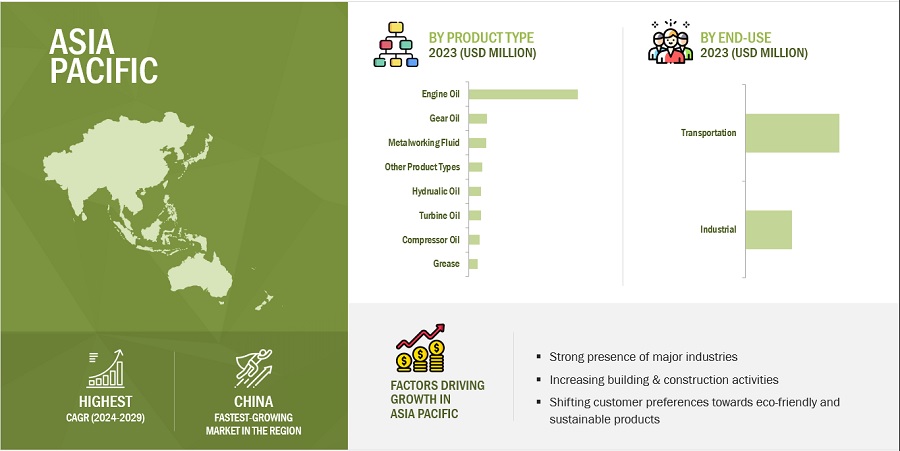
To know about the assumptions considered for the study, download the pdf brochure
Key Market Players
Shell plc (UK), Exxon Mobil Corporation (US), BP p.l.c. (UK), Chevron Corporation (US), PetroChina Company Limited (China), TotalEnergies SE (France), ENEOS Holdings, Inc. (Japan), China Petroleum & Chemical Corporation (China), Idemitsu Kosan Co., Ltd. (Japan), and among others, these are the key manufacturers that secured major market share in the last few years.
Get online access to the report on the World's First Market Intelligence Cloud
- Easy to Download Historical Data & Forecast Numbers
- Company Analysis Dashboard for high growth potential opportunities
- Research Analyst Access for customization & queries
- Competitor Analysis with Interactive dashboard
- Latest News, Updates & Trend analysis
Request Sample Scope of the Report
Get online access to the report on the World's First Market Intelligence Cloud
- Easy to Download Historical Data & Forecast Numbers
- Company Analysis Dashboard for high growth potential opportunities
- Research Analyst Access for customization & queries
- Competitor Analysis with Interactive dashboard
- Latest News, Updates & Trend analysis
|
Report Metric |
Details |
|
Years considered for the study |
2018–2029 |
|
Base year considered |
2023 |
|
Forecast period |
2024–2029 |
|
Units considered |
Volume (Kiloton) and Value (USD Million) |
|
Segments Covered |
Base Oil Type, Product Type, End-use Industry, and Region |
|
Regions covered |
Asia Pacific, North America, Europe, Middle East & Africa, and South America |
|
Companies profiled |
The key players profiled in the report include Shell plc (UK), Exxon Mobil Corporation (US), BP p.l.c. (UK), Chevron Corporation (US), PetroChina Company Limited (China), TotalEnergies SE (France), ENEOS Holdings, Inc. (Japan), China Petroleum & Chemical Corporation (China), and others.
|
This report categorizes the global Lubricants Market based on ingredient type, application, and region.
On the basis of base oil type, the Lubricants Market has been segmented as follows:
- Mineral Oil Lubricants
- Synthetic Lubricants
- Bio-based Lubricants
On the basis of product type, the Lubricants Market has been segmented as follows:
- Engine Oil
- Hydraulic Oil
- Compressor Oil
- Metalworking Fluid
- Gear Oil
- Turbine Oil
- Grease
- Other Product Types
On the basis of End-use Industry, the Lubricants Market has been segmented as follows:
- Transportation
- Commercial Vehicle
- Passenger Vehicle
- 4-Wheeler Vehicle (PCMO)
- 2-Wheeler Vehicle (MCO)
- Aviation
- Marine
- Railways
- Industrial
- Construction
- Metal & Mining Production
- Cement Production
- Power Generation
- Automotive (Vehicle Manufacturing)
- Chemical
- Oil & Gas
- Textile
- Food Processing
- Others
On the basis of region, the Lubricants Market has been segmented as follows:
- Asia Pacific
- Europe
- North America
- Middle East & Arica
- South America
Recent Developments
- In January 2024, Shell plc has completed the acquisition of MIDEL and MIVOLT, from Manchester-based M&I Materials Ltd.
- In January 2021, BP p.l.c. had set up a digital hub in Pune, India. This expansion helped them grow their digital expertise and meet the changing demands by providing sustainable solutions.
- In February 2022, Chevron Corporation made an announcement that it has signed an agreement with Bunge North America, Inc. to create renewable feedstocks.
Frequently Asked Questions (FAQ):
Which are the major players in the lubricants market?
The key players profiled in the report include Shell plc (UK), Exxon Mobil Corporation (US), BP p.l.c. (UK), Chevron Corporation (US), PetroChina Company Limited (China), TotalEnergies SE (France), ENEOS Holdings, Inc. (Japan), China Petroleum & Chemical Corporation (China), Idemitsu Kosan Co., Ltd. (Japan), and among others.
What are the drivers and opportunities for the lubricants market?
The mounting demand from marine applications and growing demand for bio-based lubricants across worldwide are the major driver for this market.
What are the various strategies key players are focusing within lubricants market?
New product launches, expansion and partnerships are some of the strategies adopted by key players to expand their global presence.
What is the CAGR of the lubricants Market?
The market is projected to grow at a CAGR of 2.7% in terms of value, during the forecast period.
What are the major factors restraining lubricants market growth during the forecast period?
increasind demand for electric vehicles is expected to restrict the market demand. .
To speak to our analyst for a discussion on the above findings, click Speak to Analyst
The study involved four major activities in estimating the market size for lubricants market. Exhaustive secondary research was done to collect information on the market, the peer market, and the parent market. The next step was to validate these findings, assumptions, and sizing with industry experts across the value chain through primary research. Both top-down and bottom-up approaches were employed to estimate the complete market size. After that, the market breakdown and data triangulation procedures were used to estimate the market size of the segments and subsegments.
Secondary Research
Secondary sources used in this study included annual reports, press releases, and investor presentations of companies; white papers; certified publications; articles from recognized authors; and gold standard & silver standard websites such as Factiva, ICIS, Bloomberg, and others. The findings of this study were verified through primary research by conducting extensive interviews with key officials such as CEOs, VPs, directors, and other executives. The breakdown of profiles of the primary interviewees is illustrated in the figure below:
Primary Research
The lubricants market comprises several stakeholders, such as raw material suppliers, end-product manufacturers, and regulatory organizations in the supply chain. The demand side of this market is characterized by engine oil, turbine oil, gear oil, grease, hydraulic oil, compressor oil, metalworking fluid, and others. The supply side is characterized by advancements in technology and diverse application industries. Various primary sources from both the supply and demand sides of the market were interviewed to obtain qualitative and quantitative information.
Breakdown of Primary Participants
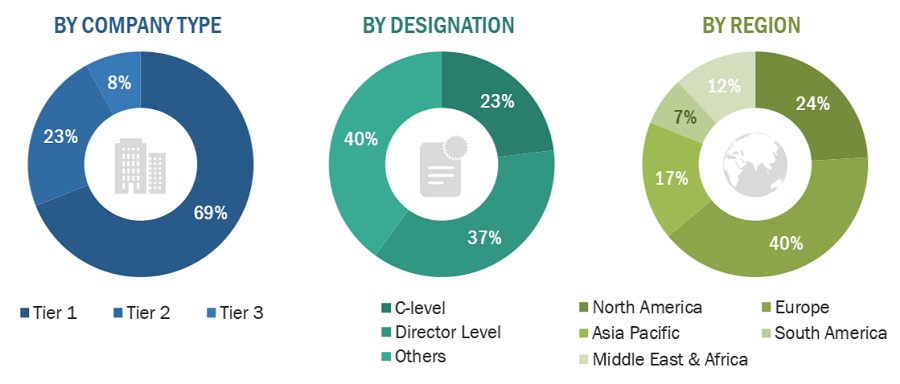
Note: Tier 1, Tier 2, and Tier 3 companies are classified based on their market revenue in 2022/ 2023, available in the public domain, product portfolios, and geographical presence.
Other designations include consultants and sales, marketing, and procurement managers.
To know about the assumptions considered for the study, download the pdf brochure
|
COMPANY NAME |
DESIGNATION |
|
Exxon Mobil Corporation |
Senior Manager |
|
Shell plc |
Innovation Manager |
|
Indian Oil Corporation Limited |
Vice-President |
|
BP p.l.c. |
Production Supervisor |
|
Chevron Corporation |
Sales Manager |
Market Size Estimation
Both top-down and bottom-up approaches were used to estimate and validate the total size of the lubricants market. These methods were also used extensively to estimate the size of various subsegments in the market. The research methodology used to estimate the market size includes the following:
- The key players in the industry have been identified through extensive secondary research.
- The supply chain of the industry has been determined through primary and secondary research.
- All percentage shares, splits, and breakdowns have been determined using secondary sources and verified through primary sources.
- All possible parameters that affect the markets covered in this research study have been accounted for, viewed in extensive detail, verified through primary research, and analyzed to obtain the final quantitative and qualitative data.
Lubricants Market: Bottom-Up Approach
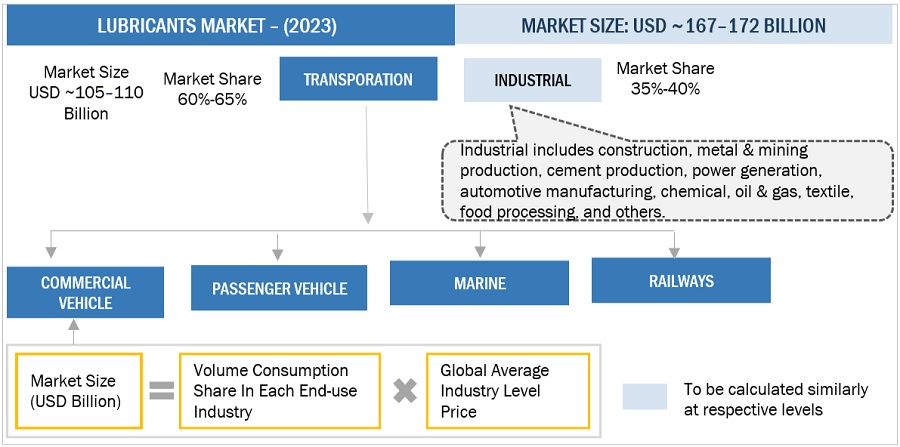
To know about the assumptions considered for the study, Request for Free Sample Report
Lubricants Market: Top-Down Approach

Data Triangulation
After arriving at the overall market size—using the market size estimation processes as explained above—the market was split into several segments and subsegments. To complete the overall market engineering process and arrive at the exact statistics of each market segment and subsegment, data triangulation, and market breakdown procedures were employed, wherever applicable. The data was triangulated by studying various factors and trends from both the demand and supply sides in the lubricants industry.
Market Definition
The lubricants market encompasses a range of substances engineered to diminish friction between surfaces, thereby reducing heat generation and facilitating the transmission of forces during movement. These substances also serve to transport foreign particles and regulate surface temperatures. Employed across diverse applications, from industrial machinery and cooking to bioapplications such as artificial joints, medical procedures, and even intimate relations, lubricants play a pivotal role in mitigating friction, wear, heat generation, noise, and vibrations within mechanical systems.
Key Stakeholders
- Lubricants manufacturers
- Lubricants suppliers
- Raw material suppliers
- Service providers
- Application sector companies
- Government bodies
Report Objectives
- To define, describe, and forecast the Lubricants market in terms of value and volume
- To provide detailed information regarding the drivers, opportunities, restraints, and challenges influencing market growth
- To estimate and forecast the market size by base oil type, product type, end-use industry, and region
- To forecast the size of the market for five main regions: Asia Pacific, Europe, North America, South America, and the Middle East & Africa, along with their key countries
- To strategically analyze micromarkets1 with respect to their growth trends, prospects, and contribution to the overall market
- To analyze opportunities in the market for stakeholders and provide a competitive landscape for market leaders
- To analyze competitive developments, such as deals and expansions, in the market
- To analyze the impact of the recession on the market
- To analyze the impact of COVID-19 on the market and end-use industries
- To strategically profile key players and comprehensively analyze their growth strategies
Available Customizations
with the given market data, MarketsandMarkets offers customizations according to the company’s specific needs. The following customization options are available for the report:
Regional Analysis
- Further breakdown of a region with respect to a particular country or additional application type
Company Information
- Detailed analysis and profiles of additional market players (up to five)




 Generating Response ...
Generating Response ...







Growth opportunities and latent adjacency in Lubricants Market